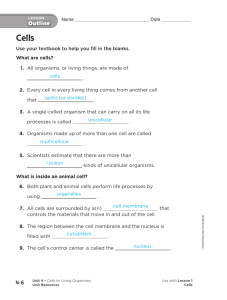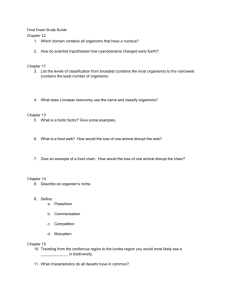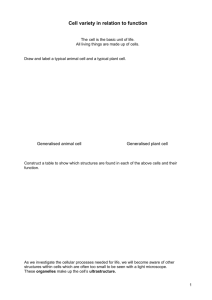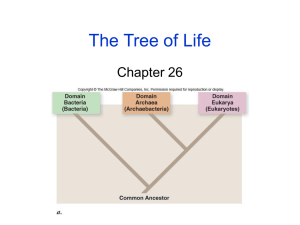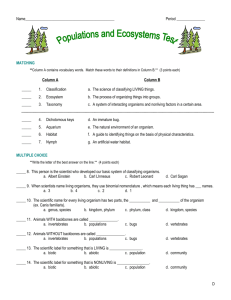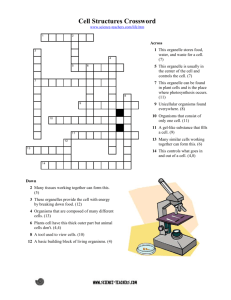The Diversity of Life
advertisement
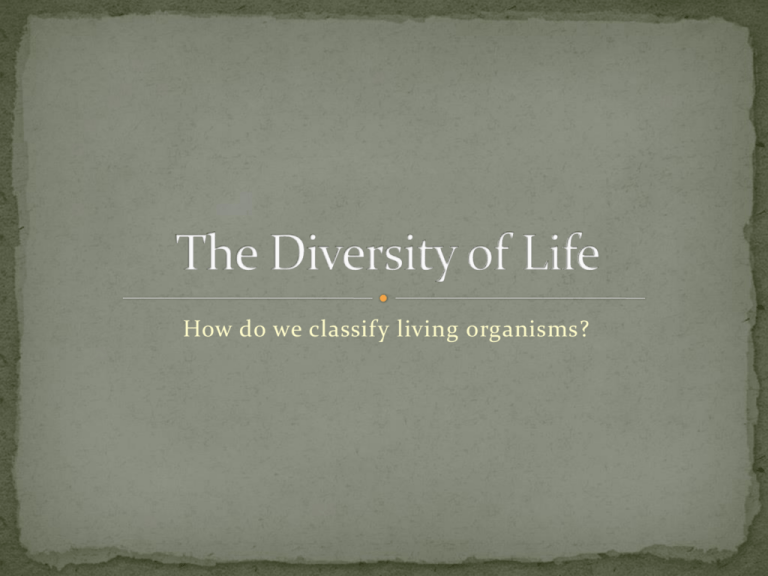
How do we classify living organisms? Taxonomy is the study and practice of classifying living organisms. Modern taxonomy uses the three domain system. Domain Archaea: Unicellular and live in harsh environments; no nuclei Domain Bacteria: Unicellular and ubiquitous; no nuclei Domain Eukarya: Conatains unicellular and multicellular organisms, all of which have a nucleus Organisms are classified by first being placed in one of those domains, and then into increasingly narrow groups, based on DNA similarities. Taxonomic ranks, order of most to least inclusive: Domain Kingdom Phylum Class Order Family Genus Species Domain Archaea contains unicellular and prokaryotic organisms. Unicellular: made up of only one cell Prokaryotic: contains no nucleus Archaea reproduce via fission, and they often live in harsh environments. Domain Bacteria contains unicellular and prokaryotic organisms. Bacteria reproduce via fission, and they are very common. They are required to support life on Earth. Domain Eukarya contains both unicellular and multicellular organisms, as long as they are eukaryotic. Multicellular: made up of more than one cell Eukaryotic: contains a nucleus Eukarya reproduce via several asexual and sexual reproductive methods, depending on the organism. Eukarya are further divided into four kingdoms: Protista Fungi Plantae Animalia Protists include a diverse collection of unicellular and multicellular organisms. Most, however, are unicellular. Individual protist species can function as animals, plants or fungi. Examples: amoebae, diatoms, some plankton Fungi include organisms with a nucleus and cell walls. Fungi are capable of absorbing nutrients from decaying organisms. They have a vital role in our biosphere as decomposers, breaking dead organisms down to recycle matter. Some fungi have a parasitic relationship with other organisms, such as athlete’s foot. Examples: Mushrooms, yeast, mold, including slime molds Which domain is associated with unicellular organisms that live in extreme environments? 2. True or false: Eukarya only reproduce sexually. 3. True or false: All eukarya have a nucleus. 4. Why are fungi so critical to our ecosystems? 1. Plants are multicellular organisms with cell walls and chloroplasts. Chloroplasts are specialized structures needed for photosynthesis. Photosynthesis generates glucose and oxygen gas from carbon dioxide and water. Plants have root systems, to draw water and nutrients from the soil. These root systems are adapted to local ecosystems. Plants also have leaves, which are the specialized structures that collect light and gases. The leaves and roots are usually connected with a vascular system. Essentially, these are vessels that transport water, minerals, and glucose. Vascular tissue has very thick cell walls, which support the plant. Some plants, such as mosses, do NOT have vascular systems. These plants must collect water from the environment, so they live in damp ecosystems. Plants are further divided into gymnosperms and angiosperms. Gymnosperms are evergreens; woody trees with needle-like leaves and cones (which contain the tree’s seeds). Gymnosperms do NOT produce fruit; instead, they produce cones which open up and release seeds. Gymnosperms can live in drier environments than other plants, as they conserve water through their cones and needles. Gymnosperms are the primary source for our lumber and paper. Examples: pines, firs, hemlocks, cypresses, spruces, yews, junipers Angiosperms are land- based flowering plants. All angiosperms produce fruits, which contain the plant’s seeds. Many flowers require the assistance of animals to scatter seeds and for pollination. Angiosperms often adapt themselves to enable pollination and reproduction. For instance, grass seeds are barbed, to latch on to other organisms. Fruit can be eaten, and the seeds scattered. Large and colorful flowers attract potential pollinators. Angiosperms are important sources of food, such as fruit, wheat and beans. Also, many angiosperms provide us with fibers and lumber. Examples: grasses, oak, palm, ivy, cactus, myrtle, peppers, cabbage, parsley, all flowers, beanproducing plants _______ are plant structures designed to collect sunlight and gasses. 2. _______ are plant structures designed to absorb water and nutrients from the soil. 3. True or false: All plants have vascular tissues. 4. Identify whether the statement describes gymnosperms or angiosperms: 1. Produce flowers and fruit b. Woody and needle-like leaves c. Cones, for containing seeds a. Animals are consumers – they cannot produce their own food. They must consume other organisms for nutrients. Animals cells do not have cell walls. This means that animals have soft and flexible bodies. Animals may or may not have a skeletal structure. Animals without a backbone are called invertebrates. Animals with a backbone are called vertebrates. Invertebrates are very diverse. Some invertebrates anchor themselves to hard surfaces in the ocean. They filter food from the water, and are called filter feeders. Examples: corals, mollusks, barnacles, several worms Other invertebrates inhabit the ocean as active consumers, whether as omnivores, hunters or scavengers. Examples: squid, lobsters, crab, octopi. Insects are the largest sub-group of invertebrates, by far. Insects have a waterproof exoskeleton, which holds in moisture. They move and reproduce quickly. Insects are often key pollinators for various ecosystems. Indeed, many plants have coevolved along with insects, and both organisms need each other to survive. Insects are also used to control pests that might harm other crops. Ladybugs are a good example. However, insects can also act as vectors for disease, and can cause damage by eating crops. Examples: butterflies, moths, beetles, flies, mosquitoes, termites, mantises, bees,wasps, grasshoppers, ants Vertebrates are also very diverse. The first vertebrates were fish, as life evolved from the oceans. Today, many vertebrates live on land. Animals include several subgroups: 1. 2. 3. 4. 5. Fish, which live entirely in aquatic environments. Many have gills, to collect oxygen. Amphibians, which are partially terrestrial and partially aquatic. Virtually all return to water to nest. Reptiles, the first true terrestrial vertebrates. They lay virtually waterproof eggs, and like fish and amphibians, are cold-blooded. Birds are warm-blooded vertebrates with feathers. Their eggs have hard shells. Mammals are warm-blooded vertebrates with fur, and are capable of producing milk. 1. Determine the kingdom of each animal from the description. Thick cell walls and chloroplasts b. Mainly unicellular, microscopic c. Includes invertebrates and vertebrates; no cell wall d. Cell wall, but they absorb nutrients from dead organisms or other organisms; decomposers. a. _________ are invertebrates, and are key pollinators in nature. 3. _________ were the first vertebrates to exist. 2.

